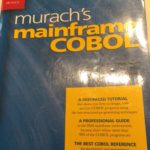Here’s a subtle gotcha that we saw recently. A miraculous tool transformed some putrid DELTA generated COBOL code from GOTO soup into human readable form. Among the transformations that this tool did, were modifications to working storage data declarations (removing unused variables in the source, and simplifying some others). One of those transformations was problematic. In that problematic case the pre-transformed declarations were:
This declaration is basically a union of char[8] with a structure that has four char[2]’s, with the COBOL language imposed restriction that the character values can be only numeric (EBCDIC) digits (i.e. ‘\xF0’, …, ‘\xF9’). In the code in question none of the U044-BIS* variables (neither the first, nor the aliases) were ever used explicitly, but they were passed into another COBOL program as LINKAGE SECTION variables and used in the called program.
Here’s how the tool initially transformed the declaration:
It turns out that dropping that first PIC and removing the corresponding REDEFINES clause, was an invalid transformation in this case, because the code used INITIALIZE on the level 01 object that contained these variables.
On page 177, of the “178 Enterprise COBOL for z/OS: Enterprise COBOL for z/OS, V6.3 Language Reference”, we have:
(copyright IBM)
FILLER
A data item that is not explicitly referred to in a program. The keyword FILLER is optional. If specified,
FILLER must be the first word following the level-number.
… snip …
In an INITIALIZE statement:
• When the FILLER phrase is not specified, elementary FILLER items are ignored.
The transformation of the code in question would have been correct provided the “INITIALIZE foo” was replaced with “INITIALIZE foo WITH FILLER”. The bug in the tool was fixed, and the transformed code in question was, in this case, changed to drop all the aliasing:
As a side effect of encountering this issue, I learned a number of things:
- FILLER is actually a COBOL language keyword, with specific semantics, and not just a variable naming convention.
- Both ‘INITIALIZE’ and ‘INITIALIZE … WITH FILLER’ are allowed.
- INITIALIZE (without FILLER) doesn’t do PIC appropriate initialization of FILLER variables (we had binary zeros instead of EBCDIC zeros as a result.)



